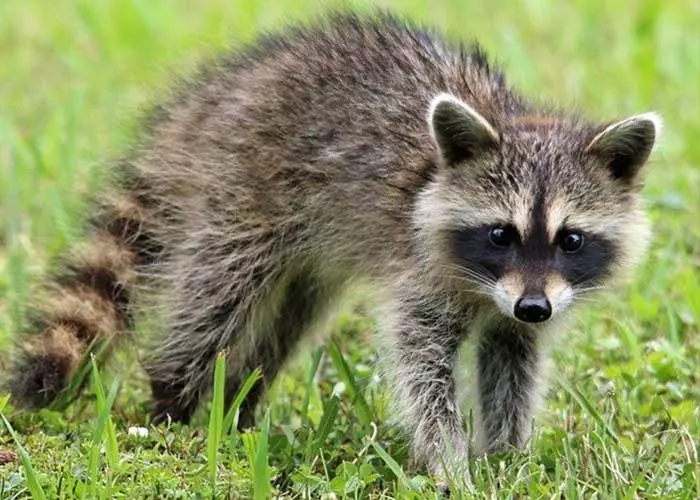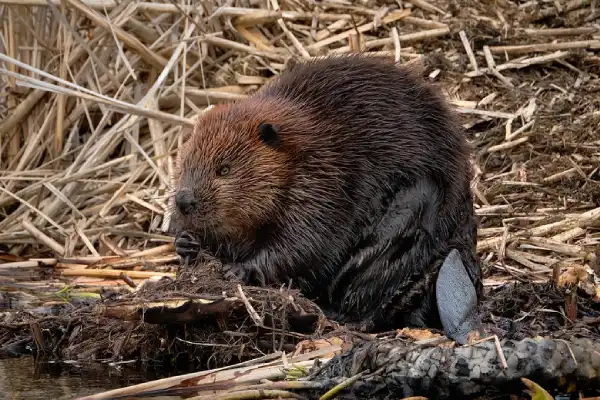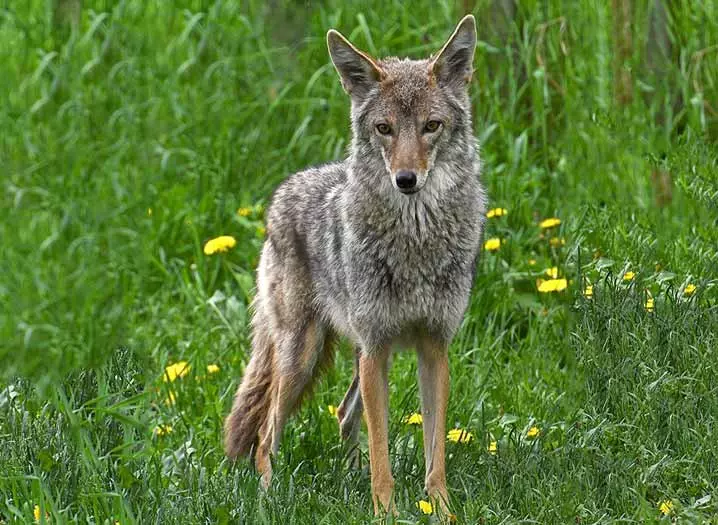Discover the hidden world that comes alive after dark throughout Ohio. From mysterious owls to stealthy raccoons, this article will explore fascinating nocturnal creatures that call the Buckeye State home.
Table of Contents
Nocturnal Animals In Ohio
1. Raccoon

- Scientific Name: Procyon lotor
Ohio is home to a thriving raccoon population that has been steadily increasing. These nocturnal creatures mate there from February to March.
During the day, they sleep in hollow trees, logs, or abandoned dens and become active at night, reaching peak activity during dark hours. While not true hibernators, they can sleep for extended periods in the cold winter months.
Known for their grayish-brown fur, black-ringed tails, and distinctive black mask around their eyes, raccoons are often spotted in urban areas, rummaging through garbage cans at night. These charismatic mammals have a well-developed sense of touch they use during feeding.
2. Virginia Opossum

- Scientific Name: Didelphis virginiana
The opossum, once rare in the state, now thrives in Ohio’s cleared lands. Found near water in shrublands and forests, they’re most abundant in the northwestern and central regions.
These creatures weigh 4 to 7 pounds and are about 6 to 8 inches tall at the shoulder, with females being smaller. Their unique fur, white at the base and black-tipped, provides a grayish-white appearance, while their hairless tails are well-suited for grasping.
Opossums feed on insects, fruits, crayfish, and more, making them highly adaptable to various habitats, from woodlands to residential areas. In Ohio, the breeding season lasts from January to October, with February and March being the most active months.
3. Beaver

- Scientific Name: Castor canadensis
The beaver, North America’s largest rodent, has a distinctive feature like a wide flat tail used in dam building and for producing alarm warnings. They’re aquatic creatures with webbed feet that can live up to 24 years!
These furbearers are prevalent around wooded ponds, lakes, and rivers, with the highest concentration in Ohio’s eastern and western parts. Over the last decade, the overall population trend in the state has remained stable to increasing.
Beavers are herbivores who feed on trees, plants, and even crops. Breeding occurs mainly in January and February, with kits leaving the lodge after 2 weeks.
4. Southern Flying Squirrel

- Scientific Name: Glaucomys volans
Southern flying squirrels are the most common squirrel species in Ohio. Strictly nocturnal and seldom seen, they can be recognized by a distinctive gliding membrane (a flap of loose skin that extends from wrist to ankle) these squirrels use to glide between trees.
They also have olive-brown fur on their upperparts and white on the underparts. Flying squirrels breed twice a year and prefer woodlands for their nests. With a diverse diet including nuts, seeds, fruits, and even insects, these nocturnal creatures contribute to Ohio’s vibrant wildlife.
5. White-tailed Deer

- Scientific Name: Odocoileus virginianus
Ohio’s nocturnal wildlife also includes the white-tailed deer, a common sight in parks, nature preserves, and even suburban backyards. Serving as the state’s sole big game animal, it has sustained generations from Native Americans to today’s sports enthusiasts.
The deer have two distinct coats, a reddish tan for spring/summer and a more insulating grayish tan for winter. Recognizable by white patches on various body parts, especially their large tails, these creatures are active from October to December.
White-tailed deer, weighing around 175 pounds for males and 120 pounds for females, display adaptability in their diet, consuming herbs, fruits, and even surviving on woody leaves when necessary. They are a resilient species found throughout Ohio.
6. Eastern Screech-Owl

- Scientific Name: Megascops asio
Eastern screech owls are small and stocky owls with big heads, large yellow eyes, small ear tufts, and horn-colored beaks. Out of all North American owls, they are the most strictly nocturnal.
Ohio’s most widespread owls, the Eastern screech-owls, can be spotted in every county. With two main color variations – red and gray – the gray morph dominates the north, while the south sees a local abundance of red morphs.
They are most vocal close to sunset and become quieter as the night progresses. Their calls are more frequent around full moons and before storms. Key calls to listen for include the characteristic “whinny” and trilling tremolo calls.
Eastern Screech-owl Call | Source: Jonathon Jongsma, CC BY-SA 3.0, via Wikimedia Commons
Other nocturnal owls found in Ohio include the barn owls, barred owls, great horned owls, long-eared owls, short-eared owls, and northern saw-whet owls. Read about other common nocturnal birds found in Ohio here.
7. American Black Bear

- Scientific Name: Ursus americanus
In the 1850s, black bears were nearly extinct in Ohio, with occasional reports in the south-central and southeastern regions. Today, these endangered species can be spotted around dusk and dawn in the eastern half of the state’s forested habitats. In 2018 alone, there were 191 recorded bear sightings across 45 Ohio counties.
Ohio’s largest land mammals, they boast a variety of fur colors, with black or dark brown being the most common. Black bears possess excellent eyesight and a remarkable sense of smell, while their good climbing and swimming skills enable them to thrive in diverse habitats.
These opportunistic eaters primarily consume berries, nuts, and plant matter but may turn to human-related food sources, becoming nuisance bears. During the breeding season in June and July, males are territorial and mate with multiple females.
Read More: List of nocturnal animals of Michigan
8. Coyote

- Scientific Name: Canis latrans
If you live in Ohio, you’ve either encountered a coyote or know someone who has, as these nocturnal animals are pretty common in the state.
Initially inhabiting the West’s deserts and prairies, coyotes expanded eastward as agriculture developed and larger carnivores disappeared. By the 1930s, they reached Ohio, becoming statewide residents by 1988. While not native to Ohio, these nocturnal creatures are now prevalent throughout the state.
These slender, grayish-brown animals with an average size of 30-45 pounds can thrive in various habitats, from mountains to suburban areas.
Coyotes are opportunistic eaters, preying on small mammals, deer fawns, and occasionally adult deer. They may also target domestic poultry and livestock.
Read More: What animals come out at night in South Carolina?
9. Red Fox

- Scientific Name: Vulpes vulpes
Red foxes are widespread in Ohio, inhabiting farmland and diverse woodland habitats, especially in the central and northwestern regions. However, their population has experienced a decline over the last decade.
They are one of two fox species found in the state (the other being the gray fox) and measure similarly to a small dog. If you see them in the wild, you will notice distinctive red or orange coloration and a long, bushy tail with a white tip.
They hunt for mice, meadow voles, and rabbits, but also consume insects, birds, eggs, fruits, and berries, in addition to scavenging carrion and garbage when available. These animals are primarily active at night and can be occasionally found in residential neighborhoods, taking advantage of available food and shelter options.
Read More: List of nocturnal animals of California
10. Bobcat

- Scientific Name: Lynx rufus
Ohio is home to the bobcat, a native species and one of seven wild cats in North America.
Nearly extirpated in the 1850s, they made a comeback in the mid-1900s, establishing a population in the eastern and southern regions. Bobcat sightings have steadily risen since the early 2000s, with 4,159 confirmed sightings from 1970 to 2021 across 81 Ohio counties.
They vary in color from grayish brown to reddish brown and have distinctive black spots on their legs and lower sides. Bobcats typically measure 16-22 inches at the shoulder and weigh between 12 to 25 lbs.
They prefer heavily forested areas and feed on cotton rats, mice, cottontail rabbits, and squirrels. They occasionally include white-tailed deer in their diet during hunting season or the fawning season.
Summary
Ohio is home to a remarkable array of nocturnal creatures. This article highlighted ten animals that inhabit the state at night, delving into the lives of American black bears, bobcats, beavers, coyotes, possums, raccoons, and others.
If you enjoyed this article, feel free to read our guide on North Carolina’s nocturnal animals